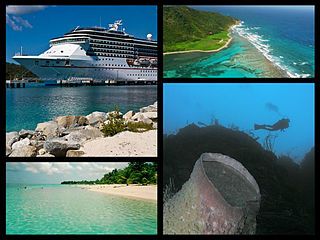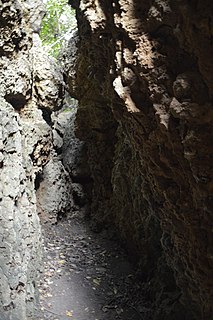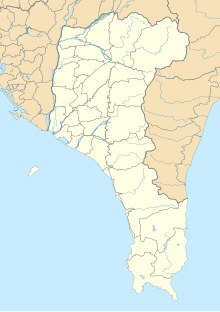
A ship burial or boat grave is a burial in which a ship or boat is used either as the tomb for the dead and the grave goods, or as a part of the grave goods itself. If the ship is very small, it is called a boat grave. This style of burial was practiced by various seafaring cultures in Asia and Europe. Notable ship burial practices include those by the Germanic peoples, particularly by Viking Age Norsemen, as well as the pre-colonial ship burials described in the Boxer Codex in the Philippines.

The Penghu or Pescadores Islands are an archipelago of 90 islands and islets in the Taiwan Strait. The largest city is Magong, located on the largest island, which is also named Magong. Covering an area of 141 square kilometers (54 sq mi), the archipelago collectively forms Penghu County of the Republic of China (Taiwan) and is the second smallest county after Lienchiang County.

The Bay Islands is a group of islands off the coast of Honduras. Collectively, the islands form one of the 18 departments of Honduras. The departmental capital is Coxen Hole, on the island of Roatán.

Pingtung County is a county in Southern Taiwan. It has a warm tropical monsoon climate and is known for its agriculture and tourism. Kenting National Park, Taiwan's oldest and largest national park, is located in the county. The county seat is Pingtung City.

Westmoreland is the westernmost parish in Jamaica, located on the south side of the island. It is situated south of Hanover, southwest of Saint James, and northwest of Saint Elizabeth, in the county of Cornwall. The chief town and capital is Savanna-la-Mar. Negril, a famous tourist destination, is also situated in the parish.

Liuqiu, also known by several other names, is a coral island in the Taiwan Strait about 13 kilometers (8 mi) southwest of Taiwan Island. It has an area of 6.8 km2 (2.6 sq mi) and approximately 13,000 residents, the vast majority of whom share only 10 surnames. It is administered as a township of Pingtung County. As of 2019 the township chief is Chen Lung-chin.

Black River is the capital of St. Elizabeth Parish, in southwestern Jamaica. It developed as a port around the mouth of the river of the same name. Today the city is a centre of environmental tourism and a gateway to the Treasure Beach resort area. Treasure Beach and Crane Beach are to the south-east, with Luana Beach to the west. In the 18th and early 19th centuries, it was a thriving sugar port with a market for African slaves.

Cueva de los Verdes is a lava tube and tourist attraction of the Haria municipality on the island of Lanzarote in the Canary Islands (Spain). The cave lies within the Monumento Natural del Malpaís de La Corona, a protected area of the Canary Islands.

Hengchun Township is a township located on the southern tip of the Hengchun Peninsula in Pingtung County, Taiwan. It is the southernmost township in Taiwan. Hengchun is also the only urban township in the southern part of Pingtung County. Hengchun has a land area of 136.76 km2 (52.80 sq mi) and has a population of 30,859 as of December 2014.
The Liuqiu or Lewchew of the Book of Sui and other medieval Chinese texts was a realm said to have existed in the East China Sea. During the 18th and 19th centuries, it was referred to as Liukiu in English; and, Lieou-kieou in French. It is variously identified with Taiwan Island, the Penghu or Pescadore Islands, and the Ryukyu Archipelago.

Tarutao National Park consists of 51 islands in the Strait of Malacca, off the coast of Satun Province of southern Thailand. The Tarutao National Park consists of two island groups: Tarutao and Adang-Rawi, which are scattered from 20 to 70 kilometres' distance from the south-westernmost point of mainland Thailand. The park covers an area of 1,490 square kilometres. The southernmost end of the park lies on the border with Malaysia, just north of Langkawi. Tarutao became Thailand's second marine national park on 19 April 1974. The coastal Khao Sam Roi Yot National Park had been designated in 1966.

Shoushan is a mountain in Gushan District, Kaohsiung, Taiwan, north of the main entrance to Kaohsiung Harbor. It was named Ape Hill by the Dutch in the 17th century to describe many monkeys on this mountain. It is also called Chaishan (柴山) and includes the Snake Hill in its northern part, and Long Life Hill (壽山) – named by Japanese in 1911-1915 for the crown-prince Hirohito – in the southern part. In some old maps, the peak of the hill is called Saracen's Head. Now it is a nature park where biological diversity can be seen.

Biševo is an island in the Adriatic Sea in Croatia. It is situated in the middle of the Dalmatian archipelago, five kilometers southwest of the Island of Vis. Its area is 5.8 km2 (2.2 sq mi) and it has a population of 15.

Storybook Land Canal Boats is an attraction located at the Disneyland and Disneyland Park (Paris) theme parks. Passengers embark on a leisurely paced outdoor boat ride through a winding canal featuring settings from Disney animated films recreated in miniature. The Disneyland version was one of the original attractions when the park opened on July 17, 1955, although the miniature buildings and landscaping were not added until the following year. The version in Disneyland Paris is named Le Pays des Contes de Fées and opened in the spring of 1994.

The Lamey or Liuqiu Island Massacre was the slaughter of aboriginal inhabitants of Liuqiu Island off the coast of Taiwan by Dutch soldiers in 1636. The killings were part of a punitive campaign in retaliation for the massacre of shipwrecked Dutch sailors in two separate incidents in 1622 and 1631 by natives of the island.
The Penghu National Scenic Area is one of the National Scenic Areas of the Republic of China (Taiwan), and covers most, but not all of the islands and islets that form Penghu County. These islands have a total of 320 kilometers of shoreline. A National Scenic Area is not a National Park. National Scenic Areas fall within the control of the Tourism Bureau of the Ministry of Transportation and Communications of the Republic of China, while national parks fall within the jurisdiction of the Ministry of Interior of the Republic of China. The philosophies that govern the development of the two types of areas differ. For a national park the emphasis is on the preservation of natural and cultural resources, and development for human utilization is definitely a secondary priority. For a national scenic area, the priorities are more balanced between preservation and tourism utilization. This has led to conflicts between preservationists and those more favorable to the development of the area. The National Park Law of the Republic of China only applies to the latter areas. Studies about the project were first debated since the beginning of 1990 and, after a year of evaluations carried out by the Tourism Bureau of the Ministry of Transportation and Communications of the Republic of China, it was officially created in February 1991, when the Penghu office was finally established. The aim of the project was to "efficiently utilize the local resources and help Penghu's economic growth", while building vacation spots on the coast of Taiwan's only island county to attract both Taiwanese nationals and foreigners, making of Penghu an "International tourism vacation center". It is a well known scenic area for its sandy beaches. The tourist season in Penghu starts in April and peaks from June through August. The Scenic Area attracts thousands of weekenders with its brisk sea breezes and scenery. But when the autumn gales begin to blow in October, the archipelago becomes deserted until April, when warmer weather seems to thaw the local tourism industry. In addition to its rich oceanic resources, Penghu offers fantastic sights of basalt column formations. The scenic area lures more than 200 species of migratory birds, making it an important spot for Asia's birdwatchers. It was not always like this: for much of the second half of the past century, the Government of the Republic of China saw the islands in mainly political and military terms, as a naval base: "Penghu was regarded as a military base until the early 1990s. As a result, the central government never wanted to develop the islands, which resulted in Penghu's shortages of water and electricity and, of course, a lot of five-star hotels".

The Dutch Virgin Islands is the collective name for the enclaves that the Dutch West India Company had in the Virgin Islands. The area was ruled by a director, whose seat was not permanent. The main reason for starting a colony here was that it lay strategically between the Dutch colonies in the south and New Netherland. The Dutch West India Company was mainly affected by the competition from Denmark, England and Spain. In 1680 the remaining islands became a British colony.

Beauty Cave is a cave in Liuqiu Township, Pingtung County, Taiwan. It is administered as a scenic area whose ticket also includes access to nearby Mountain Pig Ditch and Black Dwarf Cave.

Lobster Cave is a cave on Liuqiu Island, off Pingtung County, Taiwan.

Cheung Po Tsai Cave is a natural cave where the famous Guangdong pirate Cheung Po Tsai, according to legend, kept his treasures. It is located on Hong Kong's outlying island of Chueng Chau and is a popular attraction of it. No treasures have been found in the cave.



















